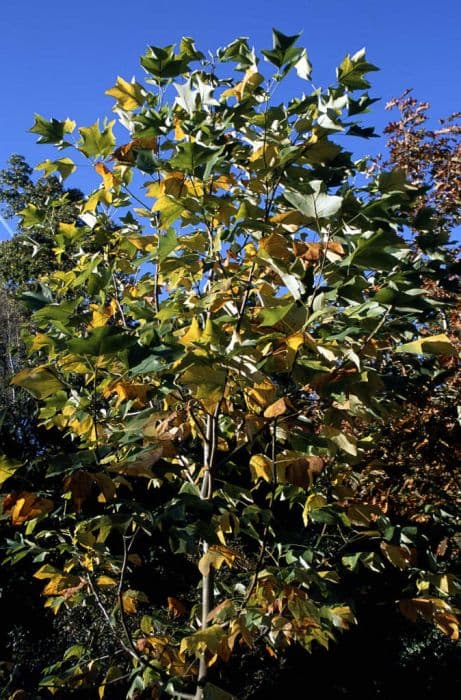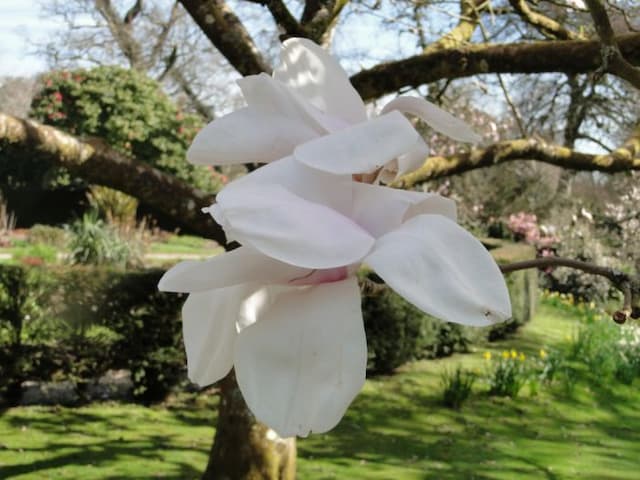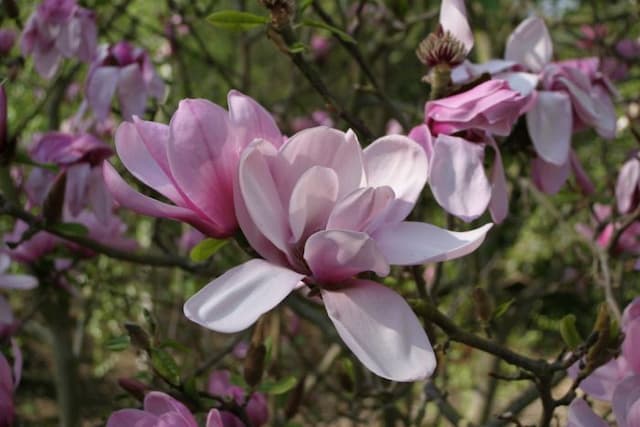Magnolia Magnolia sprengeri var. diva 'Copeland Court'

ABOUT
Magnolia 'Copeland Court' is a visually striking plant known for its large, bright flowers. These blooms showcase petals that are rich pink on the outside with a softer, paler shade on the inside, creating a captivating two-tone effect. They bloom prolifically and are fragrant, adding a sensory delight to the garden beyond just their visual beauty. The flowers have a classic cup-shaped form synonymous with magnolias, growing in an elegant, upright manner that further accentuates their appeal. The leaves of this plant are glossy and deep green, providing a lush backdrop that makes the flowers stand out even more. In the fall, the leaves may take on warm bronze tones before they drop, adding seasonal interest to the plant's appearance. Overall, Magnolia 'Copeland Court' is renowned for its breathtaking floral display and the contrasting beauty of its foliage.
About this plant
 Names
NamesFamily
Magnoliaceae.
Synonyms
Sprenger's Magnolia, Diva Magnolia.
Common names
Magnolia sprengeri var. diva 'Copeland Court'.
 Toxicity
ToxicityTo humans
Magnolia sprengeri var. diva 'Copeland Court', commonly known as Magnolia, is not known to be toxic to humans. Generally, the various species of Magnolia are not considered poisonous and there is no significant evidence that suggests the plant parts are harmful if ingested. However, like with any plant material, individual allergic reactions are always a possibility, and it's generally advisable to avoid eating plant parts that are not known to be edible.
To pets
Magnolia sprengeri var. diva 'Copeland Court', commonly referred to as Magnolia, is not considered toxic to pets. Magnolias are typically safe for dogs, cats, and other animals, and there is no widespread evidence of any part of the Magnolia causing poisoning in pets. Ingesting large amounts of plant material can sometimes lead to gastrointestinal upset in animals, so while not toxic, it's still a good practice to prevent pets from consuming the leaves, flowers, or branches.
 Characteristics
CharacteristicsLife cycle
Perennials
Foliage type
Deciduous
Color of leaves
Green
Flower color
Pink
Height
10-20 feet [3-6 meters]
Spread
6-15 feet [2-4.5 meters]
Plant type
Tree
Hardiness zones
7
Native area
China
Benefits
 General Benefits
General Benefits- Aesthetic Appeal: Produces large, fragrant pink flowers that are visually striking and can enhance the beauty of gardens and landscapes.
- Wildlife Attraction: The flowers provide nectar to pollinators like bees and butterflies, supporting biodiversity.
- Shade Provider: As a larger tree, Magnolia sprengeri var. diva 'Copeland Court' can offer shade in gardens and parks, creating cooler microclimates.
- Seasonal Interest: Offers year-round interest with its spring blossoms, summer foliage, and sometimes colorful fall leaves.
- Cultural Significance: Magnolias are often associated with the American South and can represent history and tradition in landscape design.
 Medical Properties
Medical PropertiesThis plant is not used for medical purposes.
 Air-purifying Qualities
Air-purifying QualitiesThis plant is not specifically known for air purifying qualities.
 Other Uses
Other Uses- Artistic Inspiration: Magnolia blossoms are often used by artists and photographers for their striking beauty and can inspire various forms of art.
- Education: The Magnolia sprengeri 'Diva' can be used in botany classes for teaching about plant taxonomy and diversity.
- Fragrance Extraction: The flowers can be used to create natural perfumes or scented oils due to their aromatic qualities.
- Dye Source: The bark of the Magnolia can sometimes be used to extract plant-based dyes for textile coloring.
- Culinary Decoration: Petals of the Magnolia can be crystallized or used fresh as an elegant decoration for fine pastries and desserts.
- Mood Enhancer: The sight and scent of Magnolia flowers in a garden or park setting can contribute to emotional well-being and stress relief.
- Cultural Celebrations: Magnolia flowers can be used in festivals and cultural celebrations, especially in East Asia where they are highly revered.
- Woodworking: While not commonly used due to the tree's value as an ornamental plant, the wood of the Magnolia can be utilized in woodworking for its fine grain.
- Floral Crafts: Dried Magnolia petals and leaves can be used in creating floral arrangements, wreaths, or potpourri.
- Wedding Decor: The elegant appearance of Magnolia flowers makes them suitable for use in wedding bouquets and venue decorations.
Interesting Facts
 Feng Shui
Feng ShuiMagnolia is not used in Feng Shui practice.
 Zodiac Sign Compitability
Zodiac Sign CompitabilityMagnolia is not used in astrology practice.
 Plant Symbolism
Plant Symbolism- Purity: Magnolias are often associated with purity due to their pristine and delicate white flowers.
- Dignity: The striking appearance of the magnolia suggests a sense of dignity and nobility, making it a symbol of self-respect and pride.
- Perseverance: As an ancient species, magnolias symbolize endurance and long life, often outlasting many other plants in the landscape.
- Feminine beauty: The magnolia's elegant and graceful form has made it a symbol of feminine beauty and gentleness.
 Water
WaterCopeland Court Magnolias require consistent moisture, especially during the growing season. Water them deeply once a week, providing about 1 to 1.5 gallons per watering session for newly planted trees. Mature trees may require less frequent watering but in greater quantities, potentially up to 2 gallons depending on the size and weather conditions. During hot, dry spells, increase watering to twice per week. Ensure the soil is well-draining to prevent root rot, and reduce watering in the winter when the tree is dormant.
 Light
LightCopeland Court Magnolias thrive in full sun to partial shade. They perform best with at least 4-6 hours of direct sunlight each day. A spot that receives morning sun with some afternoon shade is ideal to protect the blooms from the harsh afternoon sun which can cause them to fade more quickly.
 Temperature
TemperatureCopeland Court Magnolias are hardy and can withstand a range of temperatures; they can survive brief periods of temperatures as low as 0 degrees Fahrenheit. However, the ideal temperature range for promoting healthy growth is between 60 and 70 degrees Fahrenheit. They can tolerate up to the mid-90s Fahrenheit before they start showing signs of stress.
 Pruning
PruningCopeland Court Magnolias should be pruned to maintain shape and remove any dead or broken branches. The best time to prune is after the tree has finished blooming in spring to avoid cutting off any of the next season's buds. Light pruning can be done annually, focusing on thinning out dense areas to improve air circulation within the canopy.
 Cleaning
CleaningNot needed
 Soil
SoilSprenger's Magnolia prefers a moist, well-draining soil mix rich in organic matter with a slightly acidic to neutral pH, ideally between 5.5 and 7.0. A mix of loam, compost, and pine bark can provide the necessary nutrients and texture.
 Repotting
RepottingSprenger's Magnolia typically does not require frequent repotting. Assess the need every 3-5 years and repot in spring if the plant has outgrown its container or the soil is depleted.
 Humidity & Misting
Humidity & MistingSprenger's Magnolia thrives in moderate to high humidity levels. While it can tolerate lower humidity, aiming for a range of 40-60% is beneficial for optimal growth.
 Suitable locations
Suitable locationsIndoor
Grow Sprenger's Magnolias indoor only if space allows; they prefer outdoors.
Outdoor
Plant in moist, acidic soil with sun to partial shade and shelter.
Hardiness zone
7-9 USDA
 Life cycle
Life cycleMagnolia sprengeri var. diva 'Copeland Court' begins its life as a seed, typically requiring stratification to break dormancy before it germinates in early spring. The seedling stage involves the development of a basic root system and the initial set of true leaves. As it transitions into a young tree, it establishes a stronger root system, a woody stem, and a more complex leaf structure. During the juvenile phase, the magnolia gradually matures and increases in size, reaching reproductive maturity after several years, which is marked by the production of large, fragrant flowers that bloom in late winter to early spring before the leaves emerge. Once mature, the tree enters a long flowering phase, annually producing flowers and seeds that attract pollinators and disperse for propagation. The magnolia's lifecycle concludes when it eventually succumbs to environmental stresses, age, disease, or competition, leading to senescence and death.
 Propogation
PropogationPropogation time
Spring
Magnolia sprengeri var. diva 'Copeland Court', commonly known as Copeland Court Magnolia, is best propagated through seed collection and sowing. This method involves collecting the ripe seeds from the cones in the fall, cleaning them to remove the fleshy seed coat, and sowing them immediately in a cold frame or a sheltered outdoor seedbed. The seeds require a period of stratification, which is a process of exposing them to cold temperatures (32-40 degrees Fahrenheit or 0-4.4 degrees Celsius) to break their dormancy and encourage germination. After stratification, which lasts for about three to six months, seedlings emerge in the spring and can be cultivated until they are strong enough to be transplanted to their permanent locations. Seed propagation maintains the genetic diversity of this magnificent ornamental tree, but it's worth noting that seedlings may not always be true to the parent plant in terms of exact flower shape and coloration.









![Magnolia [Felix Jury]](/_next/image?url=https%3A%2F%2Fplants-admin.emdemapps.com%2Fimages%2Fplants%2F%2Fimages%2F604b61a0b23b7.png&w=640&q=75)